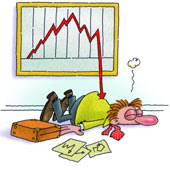 Attempts to fix the current economic recession have been on the front page for months as bailout plans and ideas abound to lend a helping hand to those entities that created debt of such gigantic proportions to be considered too large to fail.
Attempts to fix the current economic recession have been on the front page for months as bailout plans and ideas abound to lend a helping hand to those entities that created debt of such gigantic proportions to be considered too large to fail.
Are there any ways to fix the dilemma we’re in? Bill Fleckenstein had some thoughts on this topic in a story titled “A recession the Fed can’t easily fix:”
Most of the recessions in this country over the past 50 years were caused by the Federal Reserve raising interest rates to battle inflation. The two most recent recessions, though, were created not by Fed tightening but as a consequence of its reckless easy-money policies followed by the exhaustion of, first, the tech-stock bubble and, later, the housing bubble.
Thus, this is not a recession that can be easily stopped by the Fed simply relaxing monetary policy, as might have occurred in the old days. (Of course, the Fed hasn’t just relaxed policy — it has moved the monetary equivalent of heaven and earth.)
I have been predicting for a few years that the bursting of the housing bubble, in combination with the unwinding of the epic credit binge, was going to lead to extreme carnage on the downside, as consumers and financial institutions would both be impaired. That is where we are today.
Now the Fed has done what it’s done and will promise to do more. At last week’s meeting of the its Open Market Committee, the Fed essentially said it might as well hold future meetings at Strategic Air Command headquarters outside Omaha, Neb., so as to be closer to the B-52s it will need to deliver money to the country posthaste.
For any doubters out there, please note the last paragraph of the committee’s communiqué: “The Federal Reserve will purchase large quantities of agency debt and mortgage-backed securities . . . and it stands ready to expand its purchases of agency debt and mortgage-backed securities as conditions warrant. . . . The committee is also evaluating the potential benefits of purchasing longer-term Treasury securities.”
In other words, the Fed went for it, corroborating the view that many of us have held for some time: that when push came to shove, the central bank would let nothing stand in the way of printing any amount of money and monetizing anything required to fend off the ill effects of the collapsing bubble.
There’s an unwritten sequel to this story: The Fed will be exceedingly slow to remove that liquidity. Thus, whenever the economy stabilizes, at whatever level, the rate of inflation seen shortly thereafter will be quite substantial, I would guess.
I’m sure the new administration will create equally gargantuan stimulus programs. But in my opinion, we’re still going to have a brutal recession, and it will be longer and deeper than most people believe.
I expect that the rally now under way in fits and starts will not last all that long into 2009 and that it will set up a rather attractive short-selling opportunity. Those who are overexposed to equities might want to think about using the strength to lighten up, if my thought process makes sense to you.
My working hypothesis, although just a guess at this point, is that sometime around the coronation of Barack Obama might be as good a juncture as any for the market to flip over, if it actually does rally into the third week of January. Of course, that guesswork will be subject to change.
Bill’s viewpoint pretty much reflects my thinking as well. I simply can’t see how a credit bubble of epic proportions will simply be over in a few months without deep repercussions.
The big question is whether this current short-term up move off the (temporary) bottom has enough muscle to penetrate the long-term trend line of our domestic Trend Tracking Index (TTI), or will it fall short. These are the only two possibilities at this point.
Having a definite plan in place allows us to deal with either outcome. If the rally falls short, we will have avoided a whip-saw signal. If the current move has legs, and our Buy point gets triggered, we will move back in with a portion of our portfolios. Should a directional reversal subsequently occur, our sell stop discipline will move us back to the sidelines before the bear continues on its downward path.
In other words, we don’t need to make any predictions, we simply let the market come to us and deal with it accordingly.

Comments 4
Since this Bear is going to end some day what is your advice as to how to enter back into the market once the green light is given. Very interested in your advice since it will be trying times. Snubbers
It’s too early to tell. If the domestic TTI signals a Buy, we will move in with about 1/3 of portfolio value. Selections will be made at that time from the StatSheet depending on momentum figures.
Ulli…
Norki
As we never expected the market to drop the way it did, we never got out of it. Is it too late now? We have enough in money market for 2 yrs expenses, however out main income is from investments as we have no pension.
The auto industry knows all to well what happens when you go to zero interest rates to sell things and then you find that you can’t ween buyers off the zero percent dope.
Now it’s the FED/Treasury’s turn to learn the hard way.
G.H.